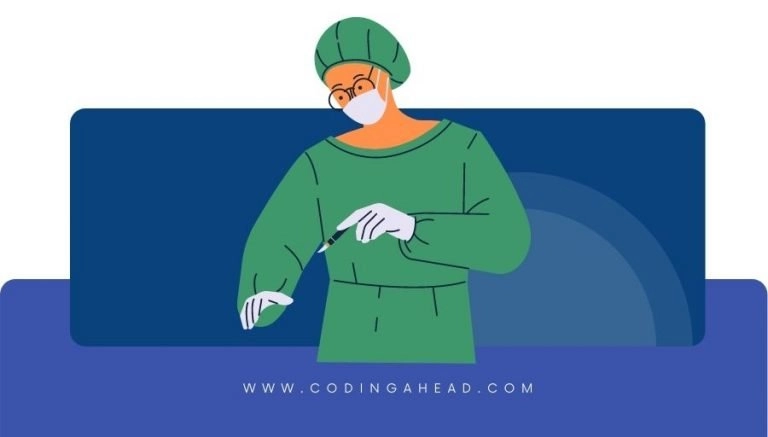(2023) How To Code Urinalysis – CPT Code Description, Guidelines & Reimbursement
The CPT code for urinalysis are CPT 81000 – CPT 81099 and used to report different methods. Underneath an explanation of the urinalysis procedure, the CPT codes for urinalysis, billing guidelines and reimbursement.
What Is Urinalysis?
Urinalysis is the study of urine to identify or screen various types of serious diseases or conditions like Kidney, Bleeding in the urinary bladder, urinary tract infection (UTI), Diabetes, liver disease, bladder stones, etc.
These tests are usually ordered by the analyses tested and the product’s brand name. There are different quantitative, semi-quantitative, and qualitative methods to screen the presence of a different analyte.
Mostly are plastic strips that contain sites with infused chemicals. It reacts with the urine when strips are dipped into the urine. It is used to screen not only various analyte but PH and specific gravity as well.
Tablets are also being used for screening purposes when a drop of urine is placed on the tablets and influence the color of urine due to chemical reactions. Therefore, these diagnostic tests are reported with different CPT codes 81000-81099 for different methods. It includes microscopy, dipsticks, tablet reagents, quantitative and semi-quantitative Urinalysis, glass test, volume measurement, etc.
CPT Code For Urinalysis Description
Urinalysis is performed by a Diagnostic laboratory that includes microscopy, reagent strips, visual examination, refractometry for specific gravity, and screening of centrifuged residue.

CPT Codes For Urinalysis
The following CPT codes are for Urinalysis:
CPT 81000 – Urinalysis that includes glucose, hemoglobin, bilirubin, nitrite, ketones, pH, leukocytes, urobilinogen, specific gravity, and number of these constituents; non-automated by dipstick or tablet reagent under microscopy.
CPT 81001 – Urinalysis that includes glucose, hemoglobin, bilirubin, nitrite, ketones, pH, leukocytes, urobilinogen, specific gravity, and number of these constituents; automated by dipstick or tablet reagent under microscopy.
CPT 81002 – Urinalysis that includes glucose, hemoglobin, bilirubin, nitrite, ketones, pH, leukocytes, urobilinogen, specific gravity, and number of these constituents; non-automated by dipstick or tablet reagent without microscopy.
CPT 81003 – Urinalysis that includes glucose, hemoglobin, bilirubin, nitrite, ketones, pH, leukocytes, urobilinogen, specific gravity, and number of these constituents; automated by dipstick or tablet reagent without microscopy.
CPT 81005 – Urinalysis; qualitative or semi-quantitative, except immunoassays.
CPT 81007 – Urinalysis; bacteriuria screen, except by culture or dipstick.
CPT 81015 – Urinalysis; microscopic only.
CPT 81020 – Urinalysis; 2 or 3 glass test.
CPT 81025 – Urine pregnancy test, by visual color comparison methods.
CPT 81050 – The volume measurement for timed collection, each.
CPT 81099 – Unlisted urinalysis procedure.
Modifiers
There is the following list of modifiers that applicable to CPT codes 81000-81099. Use modifier 22, 33, 52, 58, 59, 78, 79, 90, 91, 99, AI, CC, CR, ET, EY, GA, GC, GJ, GK GR, GU, GX, Gy, GZ, KX, Q5, Q6, QJ, QP, TH, XE, XP, XS an XU for the CPT codes for urinalysis.
Mostly 22, 52, 59 modifiers are used to attach with these CPT codes 81000-81099.
Modifier QW is appropriate to bill with these CPT 81002 and CPT 81003 only to report Clinical Laboratory Improvement Amendments (CLIA) approved codes.
If these services (CPT 81000-81099) are billed with Evaluation and management services (E/M) (CPT Code 99202-99499), then modifier 59 will be appended with CPT 81000-81099 CPT codes and 25 E/M codes if a patient shows up to the office with Diabetes and a Physician orders urinalysis to test glucose level.
The study revealed that the patient had a UTI. Therefore, It would be code like CPT 99213-25-E11.9, or CPT 81001-59-N39.0.
Modifier 22 is applicable with CPT 81000-81099 when one or more components or panels does not present in the CPT description, and also there is a separate code available for that service, then it is appropriate to add a modifier 22 for increased procedural services. Similarly, Modifier 52 will be used for reduced services.
If any component is not done during the exam and also there is no separate CPT available for the specific exam, then it would be appropriate to modifier 52 with these CPT 81000-81099.

Reimbursement
There are no RUVS for CPT codes 81000-81099, cost and unit have mentioned in the table below according to the 2022 Fee schedule regarding how frequently these services are done on the same day:
| Procedure | Modifier | Maximum Allowable amount $ | UNITS | MUE Adjudication indicator |
| 81000 | – | $4.0 | 2 | 3 DOS Clinical EDIT |
| 81001 | – | $3.2 | 2 | 3 DOS Clinical EDIT |
| 81002 | – | $3.5 | 2 | 3 DOS Clinical EDIT |
| 81003 | – | $2.3 | 2 | 3 DOS Clinical EDIT |
| 81004 | QW | $2.3 | 2 | 3 DOS Clinical EDIT |
| 81005 | – | $2.2 | 2 | 3 DOS Clinical EDIT |
| 81007 | QW | $30.0 | 2 | 3 DOS Clinical EDIT |
| 81015 | – | $30.0 | 2 | 3 DOS Clinical EDIT |
| 81020 | – | $3.1 | 1 | 3 DOS Clinical EDIT |
| 81025 | – | $4.7 | 1 | 3 DOS Clinical EDIT |
| 81050 | – | $8.6 | 2 | 3 DOS Clinical EDIT |
| 81099 | – | – | 1 | 3 DOS Clinical EDIT |
CPT Code For Urinalysis Billing Guidelines
The following are the billing guidelines to avoid denials for CPT codes 81000-81099:
All services or procedures must be billed and adhere to CMS guidelines as medically necessary and appropriate.
CPT codes 81003 and 81007 should be billed under CLIA certificate of wavier billed with QW modifier
The rest of the CPT codes accept 81003 and 81007. There is no need to append a QW modifier for a waived test.
Modifier 26, TC, or 99 must not be reported with these CPT codes (CPT 81007, CPT 81025, and CPT 81050)
Modifier 91 is applicable when frequent urinalysis procedures are done and medically necessary.
CPT 810015 cannot be billed together with CPT 81001 and CPT 81003. A modifier is also not allowed according to NCCI.
Some insurances like UHC consider CPT 81000 and CPT 81002 in the global obstetrician period when these CPT report with an OB ICD 10 codes, according to the American College of Obstetricians and Gynecologists (ACOG).
CPT Code For Urinalysis Complete
CPT Code 81003 is to bill for complete urine analysis. It would be done to detect a wide range of abnormalities like UTI, Kidney diseases, or other disorders of the urinary bladder.
CPT Code For Urinalysis Dipstick
There are four CPT codes 81000-81003 that include dipstick methods. CPT 81001 or CPT 81003 are automated and prints directly generated by the machines, while for CPT 81000 and CPT 81002 method documentation leads to documentation done by the provider.
CPT Code For Urinalysis With Culture
CPT 81001 and CPT 81002 will be reported when Urinalysis is done. If done with culture, then it would be separately reportable with CPT 87086 and CPT 87088 with culture. No modifier is required to bill these services in addition.
CPT Code For Automated Urinalysis Without Microscopy
CPT 81002 will be reported when done automated without microscopy.
CPT Code For Urinalysis Automated
CPT 81001 and CPT 81003 will be reported when automated Urinalysis is done.

Examples
The following are examples of when Urinalysis is performed by a Physician:
Example 1
60-year-old male h/o COPD, CKD, right mid ureteral stone 11/2021 requiring stent placement, the stent was removed presents c/o right flank pain for six months worsening over the past month.
The patient was sent by Dr. El-masry for hospital admission. The patient does not have any nausea, headache, vomiting, palpitations, chills, chest pain, shortness of breath.
The patient did not want to take any pain medication today. The physician spoke with Dr. Javed, who wants the patient admitted for retrograde ureterogram, Labs, UA, urine culture, IV fluids. The patient declines analgesia.
Example 2
37-year-old male with h/o GERD, endometriosis, and s/p small bowel resection 2/2 small bowel intussusception (2014), Diabetes, BIBEMS for lethargy, vomiting, abdominal pain. BGM taken on arrival to > 600.
The patient was largely unresponsive on the initial encounter. Concern for DKA. Fluids, potassium, insulin were initiated immediately. The patient unable to provide ROS or additional history has given clinical condition.
Example 3
A 52-year-old male with no active medical problems (PSHx of PTX s/p surgical repair, c/b urinary retention with Foley catheterization) presents to the ED with urinary complaints.
The patient has had progressively worsening urinary frequency, significant straining with urination, and sensation of incomplete voiding, which significantly worsened several days ago.
The patient’s wife at the bedside expressed that she is concerned about prostate enlargement or possible infection. The patient denies provocative or palliative factors for his urinary symptoms.
The patient does not have a fever or chills, no dysuria, no abdominal or flank pain, no changes in bowel movements. UA and culture are pending. The urologist would like to start on Flomax.
Example 4
The patient is a 55-year-old male with h/o HTN, complaining of frequent urination and weakness in his pelvic area since 12/29.
The patient states that he went to Dr. Pushpinder Singh today, who measured his blood sugar, and it was > 600 and so he was sent to the emergency room for evaluation and treatment.
The patient states he also has some lower extremity hyperpigmentation and edema, which has been occurring for the past three months.
He denies any pain in the legs. States he does a lot of standing at work and so is concerned about this issue. He denies any nausea, vomiting, fever, chills.
Frequent urination with elevated blood pressure is consistent with new-onset Diabetes. Physician orders Labs, Urinalysis, IV fluids.
Example 5
The patient is a 54-year-old female with a history of heart failure, hypothyroid, HTN, kidney stones, deaf in the left ear, hysterectomy, surgery for stones complaining of “my kidneys hurt” x1 week.
States she has flank pain right > left now 10/10. The patient claims that she has been vomiting since yesterday, many episodes, and now has diarrhea with black stool.
The patient states that she thinks that this could be caused by the Pepto-Bismol that she took last night. This morning she was unable to walk due to pain.
The patient has had many admissions for kidney infections for pain similar to this. The patient states that she spoke with Dr. Samorna today and this morning and was instructed to go to the emergency room for further evaluation.
Reports she feels hot and sweating but has no fever.Symptoms are consistent with kidney infection possible kidney stones. Physician Plans to order UA, Urine culture, and US scrotum.

By Uzair Ali Murtaza
Expert Medical Coding & Billing




